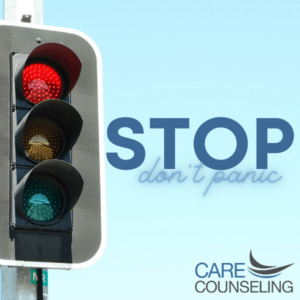The first step in stopping panic attacks is to understand what exactly defines a panic attack.
According to the DSM-5 a panic attack is defined as…
“an abrupt surge of intense fear or intense discomfort that reaches a peak within minutes”.
At least four of a possible 13 physical and cognitive symptoms are present. Simply put, “fear overwhelms”. Feeling overwhelmed is not a fun feeling, especially when your body and mind are flooded with fear!
Many individuals who seek help for panic often initially seek help at the emergency room due to the intense nature of panic attack symptoms that can mimic medical concerns such as having a heart attack. As always, it is a good idea to rule out any medical concerns and seek treatment for mental health-related symptoms.
Symptoms of panic attacks include the following:
- Palpitations, pounding heart, or accelerated heart rate
- Sweating
- Trembling or shaking
- Sensations of shortness of breath or smothering
- Feelings of choking
- Chest pain or discomfort
- Nausea or abdominal distress
- Feeling dizzy, unsteady, light-headed, or faint
- Chills or heat sensations
- Numbness or tingling sensations
- Feeling of unreality or feeling detached from oneself
- Fear of losing control or “going crazy”
- Fear of dying
Now that you are aware of panic attack symptoms, here are my Top 5 strategies that can be used to help stop panic:
1. Focus on Your Breathing
- Take slow, deep breaths in through your nose and slow, deep breaths out through your mouth.
- Try closing your eyes to tune out distractions to only focus on your breaths or try focusing on an object while breathing.
2. Ground Yourself
- Use grounding techniques that incorporate the five senses to help move through distress. A favorite is 5-4-3-2-1. What are 5 things you can see? 4 things you can touch? 3 things you can hear? 2 things you can smell? 1 thing you can taste?
3. Seek out a Soothing or Relaxing Activity
- Use an activity to divert attention from your panic sensations such as talking to someone or taking a walk. Keep in mind while distraction offers temporary relief, it is important to acknowledge and work through panic.
- Do relaxing activities that can be used on your own such as progressive muscle relaxation where muscle groups are tensed and then relaxed.
- Find a mantra that speaks to you such as “This too shall pass”.
- Remind yourself that you are having a panic attack and that it’s OK–you are not dying, not crazy, etc.
5. “Ride the Wave”
- Anxiety is here and panic has arrived. At this point, lean into the fear of panic and brace yourself for the wave ahead! Once a wave has arrived, learning how to “ride the wave” and implement coping strategies is the best thing to do.
- Learn interventions in therapy to cope with anxiety and panic, do exposure work to help reduce avoidance, and talk to your doctor about medication options.
We’re Here to help
Our wellness experts will be happy to take care of you. You can CLICK HERE to schedule an appointment now or call (612)223-8898.
Meet Clinicians
We’re united by our commitment to providing effective, relevant, and innovative mental health support at all stages of your journey. Click Here to find out more about who we are, where we come from, and how we live out CARE’s mission every day.
The professionals at CARE are actively collecting and creating resources to help with what you need. We’re Here for You.



